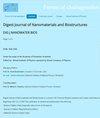Fabrication and in vitro evaluation of polyvinyl alcohol/bio-glass composite for potential wound healing applications
IF 1
4区 材料科学
Q4 MATERIALS SCIENCE, MULTIDISCIPLINARY
Digest Journal of Nanomaterials and Biostructures
Pub Date : 2023-07-20
DOI:10.15251/djnb.2023.183.821
引用次数: 0
Abstract
In this study, a novel composite is fabricated by incorporating Polyvinyl alcohol (PVA) and Bio-Glass (BG) via the freeze-thaw method. PVA pre-polymer is prepared in three different concentrations i.e. (2%, 5%, and 10%) by dissolving PVA powder in distilled water by using a hot plate magnetic stirrer at 80° C, and a constant concentration of BG i.e 2% is added into each PVA prepolymer. Total six specimens including (PVA (2%), PVA (5%), PVA (10%), PVA (2%)/BG (2%), PVA (5%)/BG (2%), and PVA (10%)/ BG (2%) were prepared in which pure PVA specimens acts as a control group. The physicochemical and mechanical properties of the specimens were examined. Various characterization tests such as scanning electron microscopy (SEM), swelling analysis, degradability analysis, hygroscopicity, pH sensitivity, tensile analysis, gel fraction test, water vapor transmission rate (WVTR), and, contact angle analysis were performed on the samples. SEM analysis showed that with the increase in PVA concentration, the material becomes smoother and more compact. Results from the current study showed that tensile strength, degradation rate, and get content are directly proportional to PVA concentration, while swelling capacity, pH sensitivity, hygroscopicity, WVTR, and hydrophilicity are inversely related to PVA concentration. Moreover, with the addition of BG, tensile strength, degradation rate, pH sensitivity, swelling capability, hydrophilicity, and, gel content of the specimens is increased, whereas, WVTR is decreased and, hygroscopicity remains unchanged. Furthermore, results from this study must be taken a step ahead & biocompatibility must be tested to evaluate the biological performance.聚乙烯醇/生物玻璃复合材料的制备及体外评价
在本研究中,通过冻融法将聚乙烯醇(PVA)和生物玻璃(BG)结合制备了一种新型复合材料。通过在80°C下使用热板磁力搅拌器将PVA粉末溶解在蒸馏水中,制备三种不同浓度的PVA预聚物,即(2%、5%和10%),并向每个PVA预聚体中加入恒定浓度的BG,即2%。共制备了6个样品,包括(PVA(2%)、PVA(5%)、PVA。对试样的物理化学和力学性能进行了检测。对样品进行了各种表征测试,如扫描电子显微镜(SEM)、溶胀分析、降解性分析、吸湿性、pH敏感性、拉伸分析、凝胶分数测试、水蒸气透过率(WVTR)和接触角分析。SEM分析表明,随着PVA浓度的增加,材料变得更光滑、更致密。目前的研究结果表明,拉伸强度、降解速率和get含量与PVA浓度成正比,而溶胀能力、pH敏感性、吸湿性、WVTR和亲水性与PVA浓度呈反比。此外,随着BG的加入,试样的拉伸强度、降解速率、pH敏感性、溶胀能力、亲水性和凝胶含量增加,而WVTR降低,吸湿性保持不变。此外,这项研究的结果必须向前迈出一步&必须测试生物相容性以评估生物性能。
本文章由计算机程序翻译,如有差异,请以英文原文为准。
求助全文
约1分钟内获得全文
求助全文
来源期刊

Digest Journal of Nanomaterials and Biostructures
工程技术-材料科学:综合
CiteScore
1.50
自引率
22.20%
发文量
116
审稿时长
4.3 months
期刊介绍:
Under the aegis of the Academy of Romanian Scientists
Edited by: -Virtual Institute of Physics operated by Virtual Company of Physics.
 求助内容:
求助内容: 应助结果提醒方式:
应助结果提醒方式:


